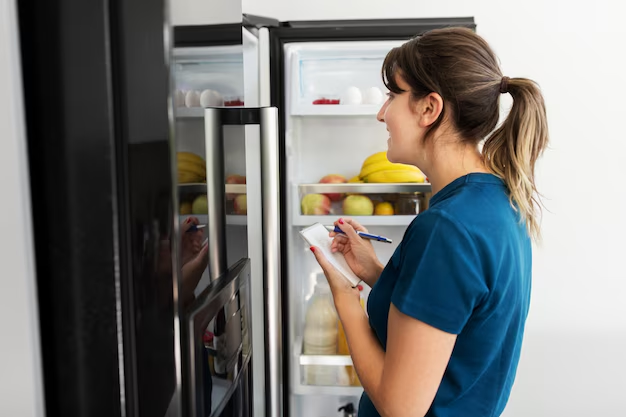Mastering Your Samsung Refrigerator: Turning it On and Off Made Simple
In today's fast-paced world, home appliances have become marvels of technology, engineered to cater to various needs. Samsung refrigerators are no exception, boasting features designed to improve convenience, efficiency, and user experience. Yet, even the most gadget-savvy individuals can sometimes find themselves stumped on seemingly simple tasks—like how to properly turn the refrigerator on and off. Whether you want to undertake a quick maintenance check, move your appliance, or prepare for a long trip, understanding the fundamental controls of your Samsung refrigerator can be incredibly beneficial.
Understanding Your Samsung Refrigerator
Before diving into the main method to turn your refrigerator on and off, it's crucial to understand the layout and functions available on your appliance. Samsung refrigerators come with a variety of buttons and controls that might initially seem overwhelming, but they are designed to provide ease and precise management of temperature and modes.
The Control Panel
The control panel is your central hub for managing your refrigerator settings. Most Samsung models feature a digital display which can be touch-sensitive or operate with physical buttons. Typically located inside when you open the fridge door, the panel allows for:
- Temperature management: Adjusting the settings for both refrigerator and freezer compartments to suit your storage needs.
- Special modes: Utilizing specific settings such as Power Freeze, Power Cool, and Vacation Mode.
- Filters and alerts: Notifying you about water filter replacements or temperature irregularities.
Turning On the Refrigerator
If your Samsung refrigerator is brand new or recovering from a power outage or maintenance, turning it back on is straightforward:
- Plug in the appliance: Ensure the plug is securely inserted into the wall socket. The appliance should automatically start.
- Temperature settings: Use the control panel to set the desired temperature for the refrigerator and freezer. Most models default to recommended settings.
- Ensure proper closing: Double-check that doors are closed properly to initiate effective cooling.
Turning Off the Refrigerator
While there might be rare occasions when you need to completely turn off your refrigerator, knowing how to do it is essential.
- Use the control panel: Locate the Power Off button or Power button combination if your model supports it. Consult your manual if unsure.
- Unplug for complete power down: For complete shutdowns, like those necessary during long cleanings or moves, unplugging the unit is the most straightforward method.
Exploring Related Features for Energy Efficiency
When considering turning your refrigerator off, you might also want to take advantage of energy-efficient features designed to enhance performance without needing a complete shutdown.
Power Freeze and Power Cool
Samsung refrigerators often offer these features to rapidly reduce the temperature in the fridge or freezer. They come in handy for situations like:
- Power Freeze: Quickly brings the freezer to its lowest temperature and is handy when adding a large number of groceries.
- Power Cool: Lowers the fridge temperature rapidly.
These modes are often activated by a simple press of a respective button on the control panel, saving you time and energy while keeping your food fresh.
Vacation Mode
If you’re going away for an extended period, consider utilizing Vacation Mode rather than turning off your refrigerator:
- This mode keeps the freezer running under normal conditions while the fridge compartment operates minimally, saving energy.
Practical Consumer Tips
To make sure you’re handling your Samsung refrigerator like a pro, here are some quick tips:
- 🔌 Regular Maintenance: Periodically unplug and inspect your refrigerator for dust accumulation on coils or signs of wear on seals and gaskets. This helps boost efficiency.
- 🧊 Temperature Checks: Maintain recommended fridge (about 37°F or 3°C) and freezer (about 0°F or -18°C) temperatures for optimal food storage.
- ⚙️ Use Modes Wisely: Leverage the appliance's various modes for energy savings and better food preservation.
Addressing General Usage Questions
In addition to knowing how to turn the unit on and off, it’s helpful to understand other frequent queries about Samsung refrigerators.
What If the Refrigerator Won’t Turn On?
If your refrigerator does not turn on, check these fundamentals:
- Power supply: Confirm the socket is working by testing it with another device.
- Breaker: Make sure the circuit breaker hasn’t tripped.
- Wiring: Inspect the plug and cord for visible damage.
What to Do During a Power Outage
In case of a power failure:
- Keep the doors shut: Retains the cold for as long as possible.
- Post-outage check: Assess for spoilage if the outage persisted for more than 4 hours.
Summary: Quick Reference Guide
🌟 Quick Tips to Master Your Samsung Refrigerator On/Off Functionality:
- Turning On: Plug into a secure socket ➔ Adjust settings.
- Turning Off: Use panel controls or unplug for complete shutdown.
- Use Energy-efficient Modes: Activate Vacation, Power Cool/Freeze for enhanced efficiency.
- During Power Outages: Keep doors closed; inspect for any spoilage post-restoration.
As you navigate the features and controls of your Samsung refrigerator, understanding these settings will empower you to make informed decisions regarding its use, optimize its performance, and extend its lifespan. Remember, handling the basic operations proficiently ensures you’re getting the most out of this household essential. Enjoy the comfort and peace of mind that comes with mastering your kitchen's key gadget!
